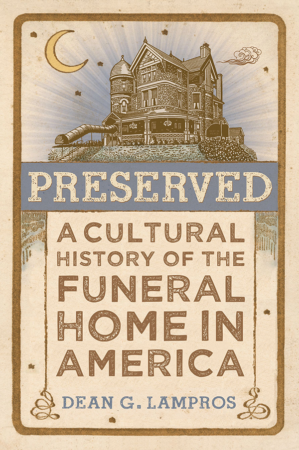Three bedrooms upstairs. That’s a minimum.
You need a big kitchen, a large back room would be a bonus, you want lots of bathrooms, and if you can get a corner lot, that’d be great. The thing you need most is a gigantic all-purpose room or maybe a ballroom because you’re planning on a lot of people. As you’ll see in the new book “Preserved” by Dean G. Lampros, not all living rooms are for the living.
Not too long ago, shortly after he took a class on historic preservation, Dean Lampros’ husband dragged him on a weekend away to explore a small town in Massachusetts. There, Lampros studied the town’s architecture and it “saddened” him to see Victorian mansions surrounded by commercial buildings. And then he had an epiphany: there was once a time when those old mansions housed funeral homes. Early twentieth-century owners of residential funeral homes were, in a way, he says, preservationists.
Prior to roughly World War II, most funerals were held at home or, if there was a need, at a funeral home, the majority of which were located in a downtown area. That changed in 1923 when a Massachusetts funeral home owner bought a large mansion in a residential area and made a “series of interior renovations” to the building. Within a few years, his idea of putting a funeral home inside a former home had spread across the country and thousands of “stately old mansions in aging residential neighborhoods” soon held death-industry businesses.
This, says, Lampros, often didn’t go over well with the neighbors, and that resulted in thousands of people upset and lawsuits filed. Some towns then passed ordinances to prohibit such a thing from happening to their citizens.
Still, funeral home owners persevered. Moving out of town helped “elevate” the trade, and it allowed Black funeral home operators to get a toehold in formerly-white neighborhoods. And by having a nice – and nice-sized – facility, the operators were finally able to wrest the end-of-life process away from individuals and home-funerals…
Here’s a promise: “Preserved” is not gruesome or gore-for-the-sake-of-gore. It’s not going to keep you up all night or give you nightmares. Nope, while it might be a little stiff, it’s more of a look at architecture and history than anything else.
From California to New England, author Dean G. Lampros takes readers on a cruise through time and culture to show how “enterprising” business owners revolutionized a category and reached new customers for a once-in-a-deathtime event. Readers who’ve never considered this hidden-in-plain-sight, surprising subject – or, for that matter, the preservation or re-reclamation of those beautiful old homes – are in for a treat here. Despite that the book can lean toward the academic, a good explanatory timeline and information gleaned from historical archives and museums offer a liveliness that you’ll enjoy.
This book will delight fans of little-know history, and architecture junkies will drool over its many photographs. “Preserved” is the book you want because there are other ways to make a house a “home.”
“Preserved: A Cultural History of the Funeral Home in America” by Dean G. Lampros
c.2024, Johns Hopkins University Press
$34.95
374 pages




